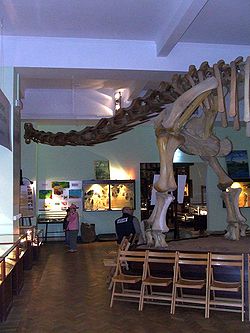- Opisthocoelicaudia
-
Opisthocoelicaudia
Temporal range: Late Cretaceous
Skeleton restoration, Poland Scientific classification Kingdom: Animalia Phylum: Chordata Class: Sauropsida Superorder: Dinosauria Order: Saurischia Suborder: Sauropodomorpha Infraorder: Sauropoda (unranked): Titanosauria Family: Antarctosauridae Genus: Opisthocoelicaudia Binomial name Opisthocoelicaudia skarzynskii
Borsuk-Białynicka, 1977Opisthocoelicaudia (from Greek opisthe [back], koilos [hollow], and Latin cauda [tail], meaning posterior cavity tail) was 12-metre-long (39 feet) sauropod dinosaur of the Late Cretaceous Period discovered in Mongolia in 1965 by Polish and Mongolian scientists in what is now the Gobi Desert. In the Cretaceous, Mongolia had instead lush jungles and murky marshes, which Opisthocoelicaudia might have waded in. The genus was described and named in 1977 by Borsuk-Białynicka as a new type of camarasaur, but studies such as Salgado and Coria (1993) find it to be a saltasaurid titanosaur instead. Its skull and neck were missing and its carcass had apparently been buried before disintegrating. Borsuk-Białynicka suggested tyrannosaurid scavengers had fed on the carcass, eating the head and neck and leaving noticeable tooth marks on the pelvis and femur. Scientists cannot be sure what its head or neck looked like, because neither was ever recovered.
Skeletally, it is generally similar to most other titanosaurs. It has, however, unique joints in the tail vertebrae which account for its unusual name. Each of the thirty four tail vertebrae has a large dome on the front and a deep hemisperical socket on the posterior, creating a series of strong ball-and-socket joints. There is also notable evidence of immense ligament and muscle tissue attached to the tail. The tail thus tends to slant slightly upwards, not downwards as in other sauropods. One possible explanation is that the tail was used as a prop to form a tripod with its back limbs, thus allowing the animal to reach high foliage.[1]
Opisthocoelicaudia has appeared on stamps in its homeland of Mongolia and in the Republic of Guinea.
Opisthocoelicaudia had more slender radii than Venenosaurus.[2]
Footnotes
References
- Cranfield, Ingrid (ed). The Illustrated Directory of Dinosaurs and Other Prehistoric Creatures. Slovenia: Salamander Books, 2000.
- Palmer, D., ed (1999). The Marshall Illustrated Encyclopedia of Dinosaurs and Prehistoric Animals. London: Marshall Editions. ISBN 1-84028-152-9.
- Salgado, L. and Coria, R.A. (1993). Considerations on the phylogenetic relationships of Opisthocoelcaudia skarzynskii (Sauropoda) from the Upper Cretaceous of Mongolia. translated by: Jeffrey A. Wilson University of Chicago Department of Organismal Biology & Anatomy June, 1997.
- Tidwell, V., Carpenter, K. & Meyer, S. 2001. New Titanosauriform (Sauropoda) from the Poison Strip Member of the Cedar Mountain Formation (Lower Cretaceous), Utah. In: Mesozoic Vertebrate Life. D. H. Tanke & K. Carpenter (eds.). Indiana University Press, Eds. D.H. Tanke & K. Carpenter. Indiana University Press. 139-165.
Categories:- Cretaceous dinosaurs
- Dinosaurs of Asia
- Titanosaurs
Wikimedia Foundation. 2010.
